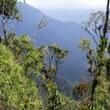Background
- Abuta grows in the Amazon basin and other humid, tropical areas of the world. It is known as a "midwife's herb" in South America and is used to treat a variety of women's complaints. In some parts of the world, abuta is used to reduce fever, inflammation, and pain. In the United States, abuta is used mainly for minor reproductive tract conditions such as menstrual cramping.
- Abuta may function as an emmenagogue (menstrual flow stimulant). However, there are no human trials that have determined the safety and effectiveness of the abuta plant on the menstrual cycle. Future research is needed before a recommendation can be made.
- Documented uses in traditional medicine show that abuta is used as a diuretic (increases urine flow), expectorant (expels phlegm), emmenagogue, and antipyretic (reduces fever). It is also used to prevent abortion, relieve heavy menstrual bleeding, and stop uterine hemorrhages (bleeding). Powdered abuta bark has also used for menstrual complaints.
References
Natural Standard developed the above evidence-based information based on a thorough systematic review of the available scientific articles. For comprehensive information about alternative and complementary therapies on the professional level, go to . Selected references are listed below.
- Ahmad R, Cava MP. Grisabine and grisabutine, new bisbenzylisoquinoline alkaloids from Abuta grisebachii. J Org.Chem 6-24-1977;42(13):2271-2273.
View Abstract - Amresh Reddy GD, Rao CV, Shirwaikar A. Ethnomedical value of Cissampelos pareira extract in experimentally induced diarrhoea. Acta Pharm 2004;54(1):27-35.
View Abstract - Anwer F, Popli SP, Srivastava RM, et al. Studies in medicinal plants. 3. Protoberberine alkaloids from the roots of Cissampelos pareira Linn. Experientia 10-15-1968;24(10):999.
View Abstract - Basu DK. Studies on curariform activity of hayatinin methochloride, an alkaloid of Cissampelos pareira. Jpn J Pharmacol 1970;20(2):246-252.
View Abstract - Bhatnagar AK, Popli SP. Chemical examination of the roots of Cissampelos pareira Linn. V. Structure and stereochemistry of hayatidin. Experientia 4-15-1967;23(4):242-243.
View Abstract - Cava MP, Saa JM, Lakshmikantham MV, et al. Panurensine and norpanurensine, new bisbenzylisoquinoline alkaloids from Abuta panurensis. J Org.Chem. 9-5-1975;40(18):2647-2649.
View Abstract - Ciccia G, Coussio J, Mongelli E. Insecticidal activity against Aedes aegypti larvae of some medicinal South American plants. J Ethnopharmacol 2000;72(1-2):185-189.
View Abstract - Fischer DC, Amorim Gualda NC, Bachiega D, et al. In vitro screening for antiplasmodial activity of isoquinoline alkaloids from Brazilian plant species. Acta Trop 2004;92(3):261-266.
View Abstract - Galeffi C, Scarpetti P, Marini-Bettolo GB. New curare alkaloids. II. New bisbenzylisoquinoline alkaloids from Abuta grisebachii (Menispermaceae). Farmaco [Sci] 1977;32(12):853-865.
View Abstract - Kupchan SM, Patel AC, Fujita E. Tumor inhibitors. VI. Cissampareine, new cytotoxic alkaloid from Cissampelos pareira. Cytotoxicity of bisbenzylisoquinoline alkaloids. J Pharm Sci 1965;54(4):580-583.
View Abstract - Morita H, Matsumoto K, Takeya K, et al. Structures and solid state tautomeric forms of two novel antileukemic tropoloisoquinoline alkaloids, pareirubrines A and B, from Cissampelos pareira. Chem Pharm Bull (Tokyo) 1993;41(8):1418-1422.
View Abstract - Ramirez I, Carabot A, Melendez P, et al. Cissampeloflavone, a chalcone-flavone dimer from Cissampelos pareira. Phytochemistry 2003;64(2):645-647.
View Abstract - Steele JC, Simmonds MS, Veitch NC, et al. Evaluation of the anti-plasmodial activity of bisbenzylisoquinoline alkaloids from Abuta grandifolia. Planta Med 1999;65(5):413-416.
View Abstract - Sur RN, Pradhan SN. Studies on cissampelos alkaloids. I. Action of hayatin derivatives on the central nervous system of cats and dogs. Arch Int Pharmacodyn Ther 11-1-1964;152:106-114.
View Abstract







